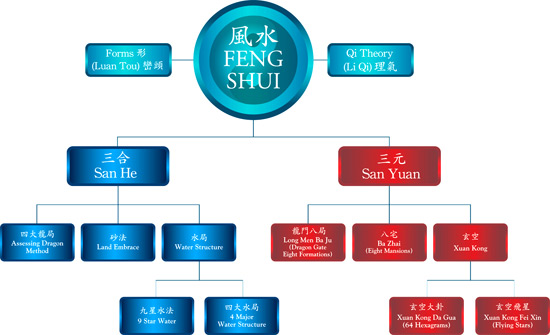It is rare to find a person these days who doesn’t know something about feng shui or ‘Wind and Water’ as so many people are apt to associate it with. In fact, what public knowledge there is about feng shui simply scratches the surface of an incredibly deep and profoundly sophisticated practice.
The universe of feng shui goes deep beyond and far further than just wind chimes and money frogs. It has systems and schools that extend far beyond Flying Star Feng Shui and Eight Mansions feng shui, the two systems that most people are familiar with.
It is much more than just tapping into the energies to improve your love life or help you get a promotion – indeed, at its most powerful, feng shui can create emperors, and give birth to empires. In this article, I would like to share with you the depth of knowledge that feng shui encompasses, how it leads to and is inter-linked with other Chinese Metaphysical subjects.
Schools of Feng Shui
To begin to understand feng shui, one must first be aware of how it came about. Briefly, feng shui originally began as a science of selecting burial grounds, what is known today as Yin House Feng Shui. It also wasn’t even known as feng shui, back then. It was known as Kan Yu. The name feng shui only came into use in the Qing Dynasty. And while it is an ancient metaphysical science, it is not really THAT old. By most documentary evidence, it is around 1200 years old and is really thought to only have gained ground and achieved its renaissance period during the Tang Dynasty.
Essentially, feng shui can be separated into two main schools. Before I delve into the two schools of feng shui proper, I must first dispel this long-standing error on the two main schools of feng shui. It is common today to see books referring to a Compass School and a Forms School of feng shui. While it is indeed true that there are two main schools of feng shui, they are certainly not distinguished in this manner.
All feng shui systems have a core set of principles and theories that are similar: for example, they all refer to the Five Elements, they all take into account the Four Factors of Residents, Time, Location and Direction. And, they all use a Compass or Luo Pan. And all schools and systems of feng shui involve taking into consideration the landform. Accordingly, it is incorrect to separate feng shui systems as either being part of the Compass School or the Forms School.
In actual fact, feng shui systems are separated according to whether or not they fall in to the Li Qi School, or the Forms School. Li Qi School focuses on the calculation of Qi through formulas. The Forms School focuses on observation of the physical environment (or landforms) to ascertain the Qi in the area.
The more technical terms for Li Qi and Forms Schools are San Yuan School of Feng Shui or the San He School of Feng Shui respectively. San Yuan and San He are what we call the founding schools of feng shui. They are like the Oxford and Cambridge of feng shui.
San Yuan and San He Systems
The San Yuan system (San Yuan means Three Cycles) is a mathematical model of the BaGua that is used to calculate the quality of Qi through time. In San Yuan, Qi is thought to be dynamic but cyclical in nature. All is in a constant state of flux, but within the flux, there are patterns and trends. With San Yuan, the objective is to ascertain which point in time is what Qi at its optimum and make use of those energies. San Yuan involves updating one’s Feng Shui to keep up with the Qi cycle and adopting a dynamic approach to stay in tandem with the changing Qi.
By contrast, San He (which means Three Harmony) focuses on the environment – the mountains, the rivers and the landforms - and looks to understand how the environment shapes and creates Qi. It is more focused on finding an optimal or strategic location in which to benefit from the Qi in the environment. San He recognises that Qi is dynamic and changes through the time but is premised on using the unchanging, or Yin, to counter the changing, or the Yang. Landform features, such as mountains and rivers, are considered permanent and unchanging through the times. San He systems do not look to adapt to the changing Qi cycle, but to insulate and outlast any unfavourable periods in the Qi cycle through superior landform.
Both San Yuan and San He take into consideration the Time and Form factor. The difference between the two is the priority they accord to each of these two factors. San Yuan focuses more heavily on the Time factor, while San He focuses more on forms. From these two founding schools, newer systems have been developed.
(Feng Shui is a highly dynamic field that is constantly being developed, even today.)
The San Yuan system has many derivative sub-systems, such as Long Men Ba Ju (Dragon Gate Eight Formations), Xuan Kong (Time and Space School), Xuan Kong Da Gua (64 Hexagrams), Xuan Kong Fei Xing (Flying Stars) and Ba Zhai (Eight Mansions).
Dragon Gate Eight Formations is based on the mathematical model of the Ba Gua and is a study of landform based on intricate calculations. It is, you could say, San Yuan’s answer to the San He Landform approach. It is premised on eight sets of Mountain and Water formations and is popular in Taiwan.
Xuan Kong incorporates the North Dipper Stars into the mathematical model of the Ba Gua and integrates Landform with Star or Qi calculations. It has spawned two sub-schools of its own, Xuan Kong Da Gua or 64 Hexagrams and Xuan Kong Fei Xing or Flying Stars.
In Xuan Kong Da Gua, the 64 Hexagrams are factored into the Time calculations and it is premised on understanding what is the Star that governs the particular period in time and the Qi pattern of that period, known collectively as the Period Luck (Yuan Yun). It is a highly precise and results orientated method.
Xuan Kong Fei Xing or Flying Stars and Ba Zhai or Eight Mansions are also systems derived from San Yuan. These are two of the more popular Feng Shui systems used today, especially for Internal Feng Shui.
In Flying Stars, a Qi map of the property is derived from calculations and then used to determine the quality of Qi in each sector of the home.
Eight Mansions by contrast is about understanding the individual and unique Qi pattern of the House, and then matching the House to the Individual.
A relatively recent addition to this family of systems is a new system known as Qi Men Dun Jia. It is a hybrid system that theoretically is not Feng Shui, but more of divination or scientific probability. It is mainly used for highly advanced time selection, such as choosing the right time to install a cure or remove a structure.
Which is better?
I prefer not to pursue the debate of which is best, because this is something that has caused the development of feng shui to be stymied for years. As modern students of feng shui, the focus, I believe, should not be what is best but what works in the given circumstances.
In any case, ultimately, both San Yuan and San He have common denominators – they all agree that the factor of Time must always be considered and that Landforms cannot be ignored. They are both premised on a mathematical model of the Ba Gua, both make use of the Five Element theory and both are firmly rooted in the concept of Yin and Yang.
And both San Yuan and San He have one goal in common: the best way to harness Qi in the environment to support one’s goals and objectives in life.








